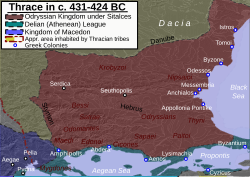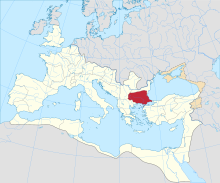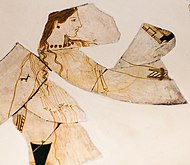Thracia
| c.480 BC–c.30 BC | |||||||||||||||||
 The Odrysian kingdom under kingSitalces(c.431–424) | |||||||||||||||||
| Capital | Uscudama(c.480–330 BC) [citation needed] Seuthopolis(c.330–250 BC) | ||||||||||||||||
| Common languages | Thracian Greek(used in writing and among trade and administration) Thraco-Illyrian | ||||||||||||||||
| Religion | Thracian polytheism | ||||||||||||||||
| Government | Monarchy | ||||||||||||||||
| Historical era | Classical antiquity | ||||||||||||||||
• Foundation | c.480 BC | ||||||||||||||||
| 340 BC | |||||||||||||||||
• Rebellion ofSeuthes III | c.330 | ||||||||||||||||
• Destruction ofSeuthopolis | c.250 | ||||||||||||||||
• Conquest of Odrysian heartlands by theSapaeans | c.30 BC | ||||||||||||||||
| Area | |||||||||||||||||
• Total | 150,000 km2(58,000 sq mi) | ||||||||||||||||
| |||||||||||||||||
| Today part of | Bulgaria Greece Turkey Romania | ||||||||||||||||
| Provincia Thracia ἐπαρχία Θρᾳκῶν | |||||||||||
|---|---|---|---|---|---|---|---|---|---|---|---|
| Provinceof theRoman Empire | |||||||||||
| 46–c. 680 AD | |||||||||||
 The province of Thracia within the Roman Empire, c. 125 AD | |||||||||||
| Capital | Heraclea Perinthus (modern-dayMarmara Ereğlisi,Turkey) | ||||||||||
| Historical era | Classical antiquity | ||||||||||
• Annexation ofThracian client state | 46 | ||||||||||
• Division byDiocletian | 293 | ||||||||||
•Theme of Thraceestablished | c. 680 AD | ||||||||||
| |||||||||||
| Today part of | Bulgaria Greece Turkey | ||||||||||


ThraciaorThrace(Ancient Greek:Θρᾴκη,romanized:Thrakē) is the ancient name given to the southeasternBalkan region,the land inhabited by theThracians.Thracewas ruled by theOdrysian kingdomduring theClassicalandHellenisticeras, and briefly by the GreekDiadochirulerLysimachus,but became aclient stateof the lateRoman Republicand earlyRoman Empireas theSapaean kingdom.Roman emperorClaudiusannexed the kingdom as aRoman provincein 46 AD.

Confines
[edit]From the perspective ofclassical Greece,Thracia included the territory north ofThessaly,with no definite boundaries,[2]sometimes to the inclusion ofMacedoniaandScythia Minor.[3]Later, Thracia proper was understood to include the territory bordered by theDanubeon the north, by the Black Sea on the east, byMacedoniain the south and byIllyriato the west,[3]roughly equivalent with the territory of theThracian kingdomas it stood during the 5th to 1st centuries BC.

With the annexation of the Thracian kingdom by theRoman Empire,by order of emperorClaudius,in AD 46,Thracia(formallyprovincia Thracia"Thracian province",ἐπαρχία Θρᾳκῶν"eparchy of the Thracians" ) was established as aRoman province.After the administrative reforms of the 3rd century,Thraciawas reduced to the territory of the six small provinces of the Diocese of Thrace.Later still, the medievalByzantinethemeofThraciacontained only what today isEastern Thrace.
Under the Principate
[edit]TheOdrysian kingdomof Thrace became a Romanclient kingdomc. 20 BC, while the Greekcity-stateson theBlack Seacoast came under Roman control ascivitates foederatae( "allied" cities with internal autonomy). After the death of the Thracian kingRhoemetalces IIIin 46 AD and an unsuccessful anti-Roman revolt, the kingdom was annexed as theRoman provinceof Thracia.[4]
The new province encompassed not only the lands of the former Odrysian realm, but also the north-eastern portion of the province ofMacedoniaas well as the islands ofThasos,SamothraceandImbrosin theAegean Sea.To the north, Thracia bordered the province ofMoesia Inferior;initially, the provincial boundary ran at a line north of theHaeumus Mountains,including the cities ofNicopolis ad IstrumandMarcianopolisin Thracia, but by the end of the 2nd century AD the border had moved south along the Haemus. The area of theThracian Chersonese(modernGallipoli Peninsula) was excluded from its governor's purview and administered as part of the emperor's personal domains.[5]The province's first capital, where the Roman governor resided, wasHeraclea Perinthus.Thracia was animperial province,headed initially by aprocurator,and, after c. 107/109, by alegatus Augusti pro praetore.Otherwise, the internal structure of the old Thracian kingdom was retained and only gradually superseded by Roman institutions. The old tribal-basedstrategiai( "generalcies" ), headed by astrategos( "general" ), were retained as the main administrative divisions, but some villages were grouped together intokōmarchiai( "village headships" ) or subordinated to neighbouring cities (the twoRoman coloniesofcolonia Claudia Aprensisandcolonia Flavia Pacis Deueltensiumand several Greek cities, many of whom were founded byTrajan), which were set apart. In the mid-1st century, thestrategiainumbered fifty, but the progressive expansion of the cities and the land assigned to them reduced their number: by the early 2nd century, they had decreased to fourteen, and c. 136 they were abolished altogether as official administrative divisions.[6]
Septimius Severus(r. 193–211), frequently traveled through Thrace during his military campaigns from 193 to 198, first during his war withPescennius Nigerand later against theParthians.The city ofPerinthus,which backed Severus, was granted the prestigious title ofneokorostwice, alongside the permission to hold crown festivals in his honor. Severus also allowedAnchialusto organizeseuereiafestivals, possibly as a reward for its support during the civil war.[7]

As it was an interior province, far from the borders of the Empire, and having a major Roman road (Via Egnatia) that passed through the region, Thrace remained peaceful and prosperous until theCrisis of the Third Century,when it was repeatedly raided byGothsfrom beyond theDanube.During the campaigns to confront these raiders, EmperorDecius(r. 249–251) fell in theBattle of Abritusin 251. Thracia suffered especially heavily in the greatGothic seaborne raids of 268–270,and it was not until 271 that EmperorAurelian(r. 270–275) was able to secure the Balkan provinces against Gothic raids for some time to come.[8]
Generally, the provincial and urban policy of Roman emperors, with the foundation of several cities of Greek type (city-state),[9]contributed more to the progress of Hellenization than to the Romanization of Thrace. So by the end of Roman antiquity, the phenomenon of Romanization occurs only upon the Lower Moesia, while Thrace lying south of the Haemus mountains had been almost completely Hellenized.[10]
As regards the Thracian dispersion outside the borders (extra fines provinciae), from epigraphic evidence we know the presence of many Thracians (mostly soldiers) throughout the Roman Empire from Syria and Arabia to Britain.[11][12]
Late antiquity
[edit]Under the administrative reforms ofDiocletian(r. 284–305), Thracia's territory was divided into four smaller provinces:Thracia,Haemimontus,RhodopeandEuropa.
The new province of Thracia comprised the northwestern portion of the old province, i.e. the upper valley of theHebrusriver between Haemus andRhodopeand includingPhilippopolis (in Thracia),which had become the provincial capital in the early 3rd century. It was headed by a governor with the rank ofconsularis.
The four Thracian provinces, along with the two provinces ofMoesia Inferior,were grouped into thedioceseofThraciae,which in turn was part of thePrefecture of the East.Militarily, the entire region was under the control of themagister militumper Thracias.[13]
See also
[edit]Notes
[edit]- ^"InHellenisticThrace, the double axe was an attribute ofZalmoxis,the god of thunder. It is also depicted on coins of Thrace as the symbol of the kings of the Odrysae, who considered Zalmoxis the ancestor and protector of the royal house. "[1]
References
[edit]- ^Kouremenos 2016,p. 46.
- ^Swinburne Carr, Thomas (1838).The history and geography of Greece.Simpkin, Marshall & Company. p.56.
- ^abSmith, Sir William (1857).Dictionary of Greek and Roman geography.London. p. 1176.
{{cite book}}:CS1 maint: location missing publisher (link) - ^Soustal (1991), pp. 59–60
- ^Soustal (1991), p. 60
- ^Soustal (1991), pp. 60–61
- ^Bertolazzi, Riccardo (2024). "The Severan Augustae as Mistresses of the World". In Hoffmann-Salz, Julia; Heil, Matthäus; Wienholz, Holger (eds.).The Eastern Roman Empire under the Severans: Old Connections, new Beginnings?.Vandenhoeck & Ruprecht.pp. 242–243.ISBN978-3-647-30251-5.
- ^Soustal (1991), p. 62
- ^D. Samsaris, Historical Geography of Western Thrace during the Roman Antiquity (in Greek), Thessaloniki 2005
- ^[1]D. Samsaris, The Hellenization of Thrace during the Greek and Roman Antiquity (Diss. in Greek), Thessaloniki 1980
- ^D. Samsaris, Les Thraces dans l' Empire romain d' Orient (Le territoire de la Grece actuelle). Etude ethno-demographique, sociale, prosopographique et anthroponymique, Jannina 1993 (University of Jannina)
- ^D. Samsaris, Les Thraces dans l' Empire romain d' Orient (Asie Mineure, Syrie, Palestine et Arabie),Dodona19 (1), 1989, p. 5-30
- ^Soustal (1991), pp. 62–63
Sources
[edit]- Soustal, Peter (1991).Tabula Imperii Byzantini, Band 6: Thrakien (Thrakē, Rodopē und Haimimontos)(in German). Vienna: Verlag der Österreichischen Akademie der Wissenschaften.ISBN3-7001-1898-8.
External links
[edit]- Mapof the Roman state according to the Compilation notitia dignitatum
- Place-names[dead link]in the Compilation notitia dignitatum


